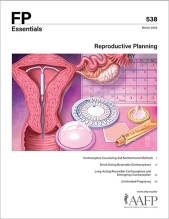
This clinical content conforms to AAFP criteria for CME.
Unintended pregnancy is seen commonly in the family medicine setting. It is defined as a pregnancy that is mistimed (occurring sooner than wanted) or unwanted (not desired at that time or any time in the future). Approximately 45% of all US pregnancies are unintended. Childbirth resulting from an undesired pregnancy has been associated with adverse maternal and child health outcomes. Clinicians should be prepared to manage unplanned pregnancies, including dating pregnancies and discussing pregnancy options. Pregnancy options counseling entails discussing the options to parent, make an adoption plan, or undergo an abortion. Because of the complexity around pregnancy intentions, a framework that places patients at the center of their reproductive decisions and engages them in collaborative decision-making during options counseling is paramount. Patients commonly seek abortion, which is considered essential health care. Because of the current legal climate surrounding abortion in many states, patients may opt to use abortion drugs without licensed clinician oversight, called self-managed medication abortion, which has been shown to be safe and effective. No states require clinicians to report known or suspected self-managed medication abortion.
Case 4. MM is a 24-year-old, gravida 4 para 3, patient who comes to your office after a positive home pregnancy test. Urine pregnancy test is positive; her last menstrual period started 5 weeks ago. She asks about her options for pregnancy termination. She says she is barely making ends meet, and another baby would cause tremendous financial strain.
Subscribe
From $350- Immediate, unlimited access to FP Essentials content
- 60 CME credits/year
- AAFP app access
- Print delivery available
Edition Access
$44- Immediate, unlimited access to this edition's content
- 5 CME credits
- AAFP app access
- Print delivery available
